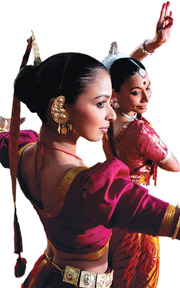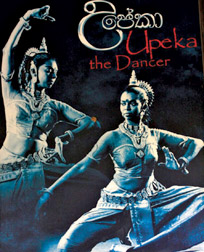|

Radiating the Old World swirl
Ruwini JAYAWARDANA
Through the dimness of lights she emerged on stage, swift-footed and
sure. Her movements drew in the crowd with magnetic force. She
gracefully turns and swirls, transcending cultures, humanity and age.
She inhales and exhales the beauty of the local dance cosmos stamped
with universal appeal.
Upeka Chitrasena, the internationally acclaimed dancer and daughter
of dance doyens Chitrasena and Vajira who has conquered the seven seas
with her brilliant dance moves disclose her true feelings on how she
took to dancing like duck to water.
|
‘Samhara’ presented by the Nrityagram Dance Ensemble in collaboration
with the Chitrasena Dance Company
* Artistic Director/ Choreographer: Surupa Sen
* Composer: Pandit Raghunath Panigrahi
* Rhythm composers: Dhaneswar Swain (India), Prasanna Rupatilake (Sri
Lanka) and Surupa Sen
* Dancers: Surupa Sen, Bijayini Satpathy and Pavithra Reddy (Nrityagram)
and Thaji Dias and Mithilani
Munasingha (Chitrasena Dance)
* Musicians: Jateen Sahu (vocal and harmonium), Sibasankar Satapathy
(mardala percussion), Srinibas Satapathy (bamboo flute), Sanjib Kuda
(violin), Surupa Sen (off-stage voice and cymbals) and Bijayini Satpathy
(cymbals) are all from India. Udaya Priyakumara (Kandyan drums) is from
Sri Lanka.
* Assistant choreographer: Heshma Wignaraja (Chitrasena Dance)
* Research/costumes/rehearsal director:
Bijayini Satpathy
* Master tailor: Ghulam Rasool Tailor
* Executive producer/ technical director/ lighting designer: Lynne
Fernandez |
 |
|
Moments from the Samhara
performance. Pictures by Rupert Lorhalder |
“Dancing was the most natural thing for me. I had perceived the
sacrifices made by my parents for the promotion of our culture and
traditions from childhood. You have to make a lot of sacrifices to excel
in dancing but for me it is not a ‘sacrifice’ because I have an ardent
love for the art,” our ‘Encounter of the Week’ explained.
Though she debuted on stage in ‘Vanaja’, a children's ballet produced
by her mother, Upeka notes that she emerged as a mature dancer in
‘Kinkini Kolama’ in 1978. In 1975 she took over 25 lead roles in the
Chitrasena dance troupe, breathing life into some of the most prominent
roles which were once portrayed by her mother. Though this was the fact
she has nevertheless carved a unique niche for herself on stage both as
a dancer as well as a teacher.
Q: You stepped into roles played by your mother in productions
like ‘Nala Damayanthi’ and ‘Karadiya'. Comparisons would have been
inevitable.
A: That is the greatest pressure that we all have. My niece,
Thaji, is undergoing the same situation. My parents never let us
undertake any character unless we were ready for it. Channa and Ravi
Bandu did lead roles in our productions and other good students too were
given prominent roles.
I was very nervous when I had to do my mother's role in the
productions.
Yes, people did compare but I worked very hard to create my own
identity. I think I have succeeded from the comments that I have gotten.
My mother gave me that opportunity by creating a lot of solos for me.
Q: You once commented that apart from the ballets produced by
the Chitrasena Kalayathanaya and Ravibandu Vidyapathy, there are no
ballets which have even come close to the standards of productions like
‘Karadiya’, ‘Nala Damayanthi’ and ‘Kinkini Kolama'. What is lacking in
these new productions?
A: Practice. Everybody goes on stage without proper
rehearsals. There is lack of discipline. They book a theatre and then
decide on what to do. You can't stage a production like that.
 That is why we do not stage shows often. You cannot give excuses to
the audience once you go on stage. It should embody the ability to hold
the audience. That is why we do not stage shows often. You cannot give excuses to
the audience once you go on stage. It should embody the ability to hold
the audience.
When a show does not start on time the audience get agitated. Once
the curtains go up we see dancers walking on stage because they do not
even know when the lights come on!
Most of the productions I have seen use a lot of Bollywood and
Western dancing techniques. We have a such a rich culture. Our Kandyan
dancing vocabulary is so vast that people do not want to dedicate time
to learn it. Everyone wants to do instant productions armed with little
knowledge.
Q: How did the Chitrasena Dance Company get the opportunity to
take part in ‘Samhara'?
A: My father was a student of Shantiniketan. He was associated
with India for many years and had been inspired by artistes like Tagore,
Mahthama Gandhi and Nehru. He always considered India his second home.
During his last stages there he had heard about Nrityagram, a dance
village located outside Bangalore and founded by the Odissi dancer
Protima Gauri Bedi in 1990.
When the Indian government and the Indian Cultural Centre invited my
father to visit India, they wanted to know what places he would like to
visit. I advised him to visit Nrityagram because it preserved the old
tradition of the students living with the gurus. It is a creative space
where dancers, musicians and choreographers live together, shared their
skills and developed their art. When my parents visited the village
Surupa Sen and Bijayini Satpathy had presented an Odissi dance
performance.
My father had emphasised the importance of exchanging art between Sri
Lanka and India to them.
He invited the dancers to live in Sri Lanka and learn Kandyan
dancing. Later the Chitrasena Dance Company students were due to visit
Nrityagram to learn Odissi. That was when the first seed of the project
was planted.
A few months later I visited the place with my niece, Umi. I took a
recording of one of my items and danced for them. They were elated by
the performance.
We started a friendship with them and whenever we visited them, they
asked us to do dancing classes for them.
Since 2003 we have been learning and admiring each other's dance
techniques and lifestyle patterns.
 |
|
Upeka Chitrasena. Picture by Nissanka
Wijeratne |
About two years back two of their dancers came to Sri Lanka and spent
one and a half months with me. We had 12 hours of dancing everyday
starting with yoga and warm up exercises. My dancers normally do not
dance everyday.
They came after work and engage in dancing till about 10 pm. However
they took part in the classes taught by these Indian dancers everyday.
That changed our outlook towards dancing.
Q: Tell us about ‘Samhara'.
A: It means ‘The Braid’ in Sanskrit and symbolizes entwining
the two dance styles. We have been working on this production since
July. Though many dance companies have done collaborations, I strongly
feel that they have not succeeded. I think this is an exceptional
production because there are moments when you are not sure which style
the dancers are actually dancing.
At times their dancers are performing the Kandyan dance. At another
instance our dancers are dancing to the Odissi beats. It is like a
continuous conversation.
We have done five pieces. Out of those, two of them are together.
Surupa Sen had choreographed the event in such a manner so that even if
there is a soloist on stage you constantly feel she has another dancer
on stage. They relate stories like the Krishna-Radha or Shiva-Parvathi.
If there are two dancers on stage they make you feel as if they are
constantly in touch with each other. They have infused that quality to
our dancers too. The production is a token of respect for each other's
dance styles and shows the strength of both techniques.
Q: Is this what you call a ‘fusion of two dance traditions'?
A: I do not know if that word is relevant to dance. I could
mean something like Western music and traditional dance together but for
me this is a collaboration. It means you have to give into the other
party.
It s a great compliment that the Nrityagram Dance Ensemble had chosen
to work with us.
I have seen Sen's work over the years and when she invited us to do a
production with her last year we were thrilled.
They premiered the show in Bangalore and toured the US. ‘Samhara’
will be showcasing at the Lionel Wendt theatre, Colombo, in May.
We will be celebrating my mother's 80th birthday with this
production.
Q: You retired from the stage after 50 years.
A: I am a very strong dancer and with age I felt that I can't
do what I used to do. Our dance is very strenuous. I decided to leave
when I am still able to dance and share my knowledge and expertise with
my students. I needed to make sure that we have good dancers for the
future.
I feel that is the best decision I have made all my life and now I am
free to handle the PR work and run the school.
Q: How do you see the potential of Heshma, Thaji and Umi being
able to take the Chitrasena dance traditions forward?
 |
|
Upeka: a
strand of a dance legacy |
A: I think it is going to be even better than when we were
around. Times have changed. They have a lot of new challenges to
overcome.
People assumed that the dance academy will collapse after my father
passed away but all of them mastered the art abroad and came back armed
with a lot of knowledge.
Heshma and Umi run the school while Thaji carries the baton forward
as the dancer.
Whenever we do a show people always expect us to meet the standards
set by my parents. We work hard and spend a lot of money on them.
We have an audience and we have proved that it will not end after my
mother or me. Hopefully the younger generation will have the support of
my younger students.
They struggle to come for rehearsals, balancing it with their other
chores, because they know how much work we do. They have realized that
if we do not take the work forward, it will die a natural death. That
will be a great void to the arts scene.
A lot of ex-dancers’ children bring their children and grandchildren
to dance. That shows that they have great faith in us.
|



